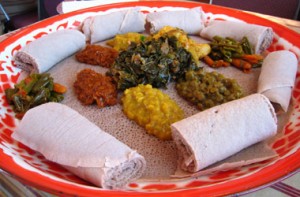Tadias Magazine
By Dr. Asqual Getaneh
Saturday, November 26, 2011
New York (TADIAS) – Whether or not it is made from toasted or raw beans, cooked thick or thin, spiced up or buttered, shiro along with other legumes is perhaps the most nourishing, ubiquitous and affordable dish in Ethiopia. Unfortunately, shiro appears less frequently on dinner tables as a result of economic and social success. The trend is an irrational and en masse adoption of Western commercial diets (along with culture and politics); yet, the same diets are the main culprits for the growing health problem in the U.S. and Europe. We grab on fistfuls of processed foods in beautifully designed packets in lieu of our traditional diet. In this, we, Ethiopians, are not alone. Very few traditions have successfully resisted the marketing lure and the temptation of colorfully wrapped easy-to-cook and ready-to-eat meals. It does not help, that no one celebrates with shiro and that it is used to express pity or religious compunction. As a result, shiro recedes even further from our esteem and creative culinary imaginations.
Against this tide, we would like to argue that shiro and other legumes should be celebrated victuals in Ethiopian households (and non-Ethiopian households) for the following reasons. First, shiro is a healthy source of both macro-and micro-nutrients. Depending on regional preferences, a typical shiro dish is made from one of three legumes, broad (fava) beans, chick peas (garbanzo) or round peas, or as in the current trend, from flour mixture of all three beans. Although there are some differences in nutrient content, each of these legumes is a low fat source of protein, carbohydrate, fiber, iron and folate, among numerous other vitamins and minerals.
For those of you worried about getting adequate protein from beans, according to the USDA the average woman and man require 46 grams and 51 grams of protein per day respectively. However, for elite athletes the daily requirement is as high as 1.37 grams per kilograms of body weight per day. A cup of shiro provides about 16.3 grams of protein. Compare this with 20 grams of protein in a serving of chicken breast, 19 grams in salmon and 22 grams in beef steak.
Second, shiro is usually served with tomato salad and vegetables such as collard greens (gomen), cabbage, or string beans and carrot (fasolia), dishes that are rich in vitamin A and C. In addition gomen and cabbage have vitamin K and folate and are filled with phytochemicals including diindolymethane, and sulforaphane — antioxidants that boost the body’s cancer fighting potential. Carrots and tomatoes have carotenoids and tomatoes contain lycopene — a specific type of carotenoid that has a strong antioxidant property. When mixed with berbere, shiro provides additional vitamin A.
Shiro as many other Ethiopian dishes is never eaten without injera, preferably injera made of teff -a super grain that rivals quinoa in its proportional protein and superior calcium and iron content. In sufficient quantities, Teff also provides a third of the daily requirement for riboflavin, niacin, vitamin B6, folate and other micronutrients. Those of us living in the United States and outside of the Washington DC area, are not lucky enough to easily obtain teff-based injera and have to resort to various other combinations that are not as nutritious and that can be more calorie dense than teff-based injera. So, when consuming non-teff based injera, it is prudent to assess calorie and carbohydrate content, especially if one is concerned about obesity, metabolic diseases or have diabetes.
Third, “shiro yum!”. Ok, we may be shooting for the stars trying to sell creamy delicious shiro to kurt-loving readers and during the holiday season. But get into your meditative zone and consider all the possible flavors in shiro like coriander, cardamom, garlic, and berbere; also visualize other bean dishes like buticha, yeshimbra asa and ful. And, if only for an interesting addition to your bean dish cornucopia, foray into the unique land of hilbet, boquilt, siljo, or gulban. I guarantee if not your taste buds your body will be tingling happily. To err is human, so if you are not convinced enough to have shiro and other legumes frequently, we hope that this will at least engage your culinary imagination to include shiro in some form in your diet.
In sum, shiro is a great source of protein; and when combined with vegetables and tomato salad shiro-based meals provide almost all of the average daily requirements of folate, vitamin A, C and K. Include the goodness of teff and the meal will have additional micronutrients such as iron, calcium and vitamin B6. For individuals concerned about carbohydrates, injera made of teff has low glycemia load by virtue of its proportional fiber and protein content (estimated glycemia load of 84 for a cup of uncooked teff, compare this to 104 for a cup of uncooked rice). Add the antioxidant properties of carotenoids and phytochemicals, and shiro and its accompaniments are now in the realm of food-as-medicine. Above all shiro tastes heavenly. At a minimum, we should curb our flight into the dizzying glitter of substitute foods, even as many in the West reverse their course through the growing slow, organic, farm-to-table and locovore food movements.
—
Related:
Our Beef with Kitfo: Are Ethiopians in America Subscribing to the Super Sizing of Food?

